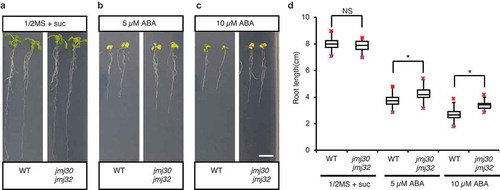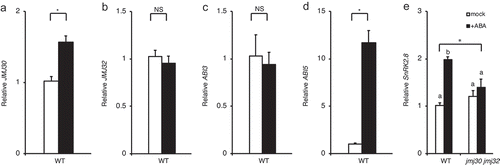Figures & data
Figure 1. Root elongation in jmj30 jmj32 double mutants is less sensitive to ABA. (A–C) Representative images of wild-type (WT) and jmj30-2 jmj32-1 plants in the absence and presence of ABA. Wild-type and jmj30-2 jmj32-1 seeds were sown on half-strength MS with 1% sucrose and stratified at 4°C for 3 days. Plants were grown under 24 h of light for 3 days and then transplanted onto half-strength MS plates with 1% sucrose supplemented with 0 µM ABA (A), 5 µM ABA (B), or 10 µM ABA (C) and grown vertically under 24 h of light for an additional 7 days. Bar = 1 cm. (D) Quantification of root length in wild-type and jmj30-2 jmj32-1 plants shown in (A–C). Asterisks indicate significant differences based on two-tailed Student’s t-test; p < .01; NS, nonsignificant. Values represent mean ± SD of 24 plants.

Figure 2. Root elongation in snrk2.8 mutants is less sensitive to ABA. (A, B) Representative images of wild-type (WT) and snrk2.8–1 plants in the absence and presence of ABA. Wild-type and snrk2.8–1 seeds were sown on half-strength MS with 1% sucrose and stratified at 4°C for 3 days. Plants were grown under 24 h of light for 3 days and then transplanted onto half-strength MS plates with 1% sucrose supplemented with 0 µM ABA (A) or 10 µM ABA (B) and grown vertically under 24 h of light for an additional 7 days. Bar = 1 cm. (C) Quantification of root length in wild-type and snrk2.8–1 plants shown in (A, B). Asterisk indicates significant difference based on two-tailed Student’s t-test; p< .01; NS, non-significant. Values represent mean ± SD of 24 plants.

Figure 3. JMJ30 and SnRK2.8 expression is induced by ABA. (A–D) Expression of JMJ30 (A), JMJ32 (B), ABI3 (C), and ABI5 (D) in wild-type (WT) plants in response to 10 µM ABA. Results are from three independent experiments. Values represent mean ± SEM. Asterisks indicate significant differences based on two-tailed Student’s t-test; p < .01; NS, nonsignificant. (E) Expression of SnRK2.8 in wild-type and jmj30-2 jmj32-1 plants in response to 10 µM ABA. Results are from three independent experiments. Values represent mean ± SEM. Asterisk indicates significant differences based on one-way ANOVA test; p < .01. Different letters indicate significant differences based on post-hoc Tukey’s HSD test; p < .01.

